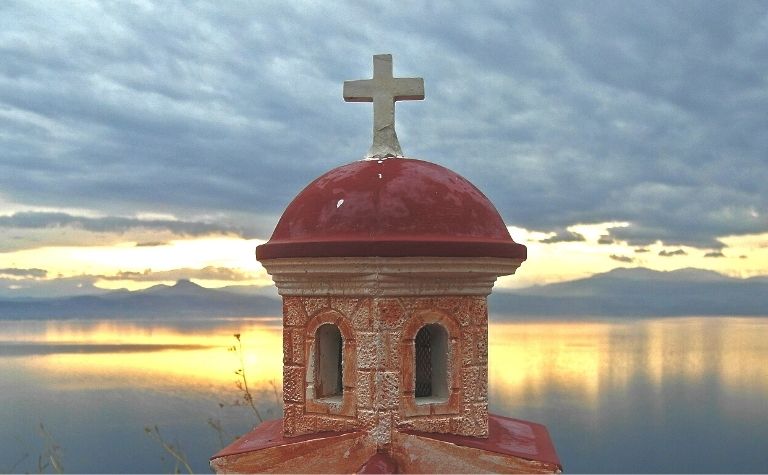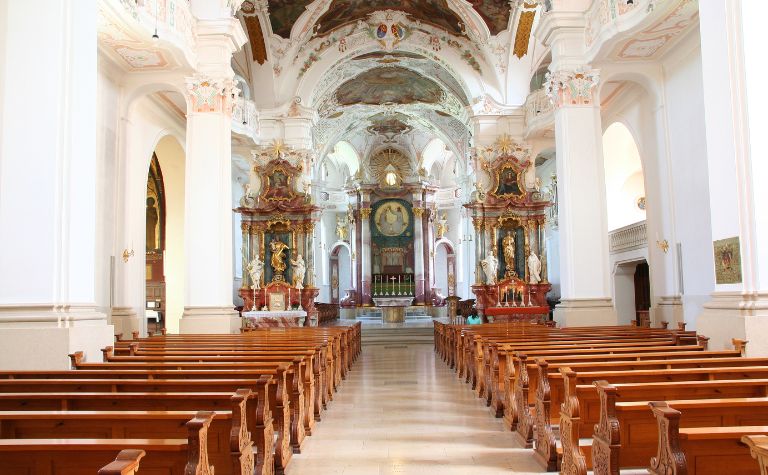The Roman Catholic Church and the Eastern Orthodox Church, along with Protestantism, comprise the three historical branches of the Christian religion. The Catholic and Orthodox branches separated from each other 1,000 years ago. Today, the two traditions have many similarities, but they have important differences, too.
The Roman Catholic Church and Eastern Orthodox Church both believe in the Trinity, the inspiration of the Bible, and the resurrection of Jesus Christ. Catholicism and Eastern Orthodoxy disagree about the procession of the Holy Spirit and the authority of the pope and have different rites or liturgies.
Is the Catholic Church or Orthodox Church larger? What exactly is their disagreement about the Holy Spirit? How do their beliefs about God, the sacraments, and icons compare? Keep reading to learn the answers to these questions and others.
Also, see Roman Catholic vs. Lutheranism: What’s the Difference? to learn more.

Compare Roman Catholicism and Eastern Orthodoxy
The Roman Catholic Church traces its history to the first century. The teachings of Jesus Christ, the role of the Apostle Peter, and the writings of the New Testament are the foundation of the theology of the Catholic Church.
The Catholic Church stresses that it alone has an unbroken chain of succession to Christ and the Apostles, whereas the Orthodox Church and Protestantism don’t. The Orthodox Church and Protestantism offer similar responses to this claim.
Both argue that the Catholic Church, at least at the time of their division, had significantly strayed from the Bible’s teachings on certain matters of doctrine and practice.
So while the Catholic Church may have a line of succession institutionally, the Orthodox Church and Protestantism contend that they possess the right theological succession.
| Roman Catholicism | Eastern Orthodox | |
|---|---|---|
| Name | The word “Roman” is derived from the city of Rome, Italy. The word “catholic,” in general use, means “universal.” In the phrase “Roman Catholic,” Catholic refers to the worldwide collection of churches in the Catholic tradition. | “Eastern” refers to the geographical area of the Orthodox tradition, whose capital was Constantinople. The “Western” church refers to Roman Catholicism, whose capital was Rome. “Orthodox” comes from a Greek word meaning “correct belief.” |
| Founding | Catholicism teaches that its origins are the origins of the church itself in the first century. The office of the pope, as Vicar of Christ, started with the Apostle Peter. | In 1054 A.D., a split occurred between the Eastern and Western churches. The division is commonly referred to as the East-West schism. The West was Catholic. The East was Orthodox.* |
| Early contributors | In addition to Peter, Paul, and the other Apostles, the first bishops of Rome, the early church fathers, including Ignatius of Antioch (died 108 AD, according to Eusebius) and Irenaeus (130-202 AD), are considered early influencers. | Early influencers in the Orthodox Church include Patriarch Michael I Cerularius of Constantinople (1000-1059), and the so-called Three Pillars of Orthodoxy: Photios I of Constantinople (810-893), Mark of Ephesus (1392-1444), and Gregory Palamas (1296-1359). |
| Roman Catholicism | Eastern Orthodox | |
|---|---|---|
| Membership | The Catholic Church reports a global membership of over 1.3 billion people. Catholicism, though rooted in the Western world, is ethnically diverse today. | The Orthodox Church reports a global membership of 220 million worldwide, making it the smallest of the three historical branches. Though the church originally consisted mostly of Greek people, today, it’s largely made up of people with Slavic origins (e.g., Russian, Ukrainian, Polish, etc.). |
| Ecumenical Councils | The Roman Catholic Church recognizes and accepts all 21 ecumenical councils. | The Orthodox Church accepts the first seven ecumenical councils of the 4th through 8th centuries. |
| Social worldview today | The Catholic Church is generally considered conservative in the context of the socio-political landscape of the 21st-century Western world. | The Orthodox Church is conservative theologically and socially, according to conventionally accepted, modern-day definitions of the term. |
*”East” and “West” refer to geographical reference points in the Mediterranean world. In a general sense, “West” refers to parts of Western Europe, and “East” refers to parts of Eastern Europe. Rome was the capital of the Western church, and Constantinople, now Istanbul, was the capital of the Eastern church.
Also, see Roman Catholic vs. Protestant vs. Orthodox: What’s the Difference? to learn more.

Catholicism and Orthodox Christianity: Similarities and Differences
The “Filioque” clause has always been one of the most significant differences between Catholicism and Eastern Orthodoxy.
“Filioque” is a Latin word that means “from the Son,” which is a reference to Jesus Christ. The term refers to who sent the Holy Spirit at Pentecost to exercise his unique ministry after the ascension of Christ.
Catholicism teaches that the Father and the Son, Jesus Christ, sent the Holy Spirit. The Orthodox Church believes that the Spirit proceeds from the Father alone, not the Son.
The disputed clause was not in the original wording of the confession articulated at The First Council of Nicea in 325 or The First Council at Constantinople in 381.
Evidence suggests it was first included at Toledo in 589 and was officially endorsed in 1017. Disagreement over the clause was a significant source of tension that led to the schism of 1054.
| Roman Catholicism | Eastern Orthodox | |
|---|---|---|
| View of the Bible | The Catholic Church teaches that the Bible is the inspired Word of God. The Catholic Bible includes the deutero-canonical literature or Apocrypha in their Old Testament (e.g., Tobit, Judith, Wisdom of Solomon). | The Bible is the source of doctrine and practice in Eastern Orthodoxy. Orthodox churches include the deutero-canonical books or Apocrypha in their Old Testament. It also includes books like 1 Esdras and Psalm 151, which appear in the Septuagint. |
| View of God | The Catholic Church teaches that God is Triune. The Father, Son, who is Jesus Christ, and the Holy Spirit, are each fully God. | Eastern Orthodoxy believes that God is Triune, but unlike Catholicism and Protestantism, it does not believe that the Holy Spirit proceeds from the Father and Son but only from the Father. |
| View of Christ | The Catholic Church believes that Jesus of Nazareth is the incarnated second person of the Trinity. He was virgin-born, sinless in life, and died for the sins of humanity. Jesus physically rose from the dead and ascended into heaven. | The second person of the Trinity became a man in the person of Jesus of Nazareth, according to Orthodox beliefs. Jesus was virgin-born and lived a sinless life. The Orthodox Church affirms the historical, physical resurrection of Christ from the dead. |
| View of Salvation | Catholicism teaches that God imparts grace to people through the sacraments. In Catholic theology, justification includes forgiveness, regeneration, and sanctification. Sanctification refers to a person’s progressive growth in holiness and Christ-likeness. | The Orthodox view of salvation is based on 2 Peter 1:4 (see below) called “deification,” which refers to a process of becoming more like God. Deification does not mean that believers will become exactly like God in his essence. |
| View of the Holy Spirit | The Holy Spirit is the third person of the Trinity. He is fully divine. The Spirit indwells Christians and gives them spiritual gifts for the edification of the Church. Catholicism believes the Holy Spirit proceeds from the Father and the Son. | The Holy Spirit is the third person of the Trinity and is fully God, according to Orthodox teachings. The Spirit is distinct from the Father and the Son. “Christ sends the Holy Spirit who proceeds from the Father,” according to Orthodox teaching. |
| Human Leader | The Pope is the Vicar of Christ and the head of the Church on Earth, an office that church teaching traces to the Apostle Peter. | The Ecumenical Patriarch of Constantinople on the head of the Orthodox Church. The Orthodox Church honors the Catholic pope but doesn’t recognize the office as having ultimate authority. |
| Roman Catholicism | Eastern Orthodox | |
|---|---|---|
| Rites | Called “Mass,” meaning “to send” in Latin, is centered on the Eucharist, which the Catholic Church teaches is the “source and summit of the Christian life.” | Called “The Divine Liturgy,” the length of the service, the use of incense, as well as images and symbols, characterize the liturgy in Orthodox churches. |
| View of the Ordinances or Sacraments | There are seven sacraments in Catholicism: (1) adult and infant baptism, (2) confirmation, (3) the Eucharist, (4) penance, (5) anointing, (6) ordination, and (7) marriage. These practices are channels of God’s grace, according to Catholic theology. | The Orthodox Church prefers the term “sacred mysteries.” Orthodox teaching conventionally lists seven: communion, baptism, Chrismation, confession, unction, matrimony, and ordination. |
| View of the Lord’s Supper | The “Eucharist,” meaning “to thank,” is a memorial in which the bread and cup become the body and blood of Christ. The change in the nature of the elements is called transubstantiation. | The Orthodox Church teaches that the bread and cup literally turn into the body and blood of Christ, but it does not attempt to explain exactly how it occurs. |
| View of the Baptism | Sometimes referred to as “paedobaptism” (paedo = “child”), according to Catholic teaching, children of Christian parents are baptized to cleanse them of original sin and regenerate them. | Bishops and priests administer baptism, in which subjects are immersed three times, once for each member of the Trinity. Eastern Orthodoxy teaches that baptism regenerates a person and makes them a member of the true church. |
| Icons | The Roman Catholic Church has icons. People use them in different ways to enhance their devotion. Some historians argue that icons in Catholicism have never had the same importance that they do in the Orthodox Church. | The Eastern Orthodox tradition, throughout its history, has strongly defended the use of icons, which they believe enhance people’s devotion to God. |
| View of the End Times | The Catholic Church affirms the Second Coming of Christ. The church’s eschatology is Amillennial. | Eastern Orthodoxy believes in the return of Christ but does not have a fully developed eschatology as many Protestant traditions do. This is due in part to the Orthodox church’s belief that the book of Revelation is a mystery. |

| Translation | 2 Peter 1:4 |
|---|---|
| KJV | Whereby are given unto us exceeding great and precious promises: that by these ye might be partakers of the divine nature, having escaped the corruption that is in the world through lust. |
| NASB | For by these He has granted to us His precious and magnificent promises, so that by them you may become partakers of the divine nature, having escaped the corruption that is in the world by lust. |
| NIV | Through these he has given us his very great and precious promises, so that through them you may participate in the divine nature, having escaped the corruption in the world caused by evil desires. |
Also, see Roman Catholic vs. Christian: What’s the Difference? to learn more.
Please see the related articles below.
Related Questions
Catholic vs. Protestant vs. Orthodox: What's the Difference?
Roman Catholicism, Protestant Christianity, and the Eastern Orthodox Church are the three historical branches of the Christian religion. Each tradition traces its doctrines and practices to the New...
The Roman Catholic and Presbyterian branches of the Christian faith trace their origins to Jesus of Nazareth and his apostles, as well as their writings that comprise most of the New Testament. There...
